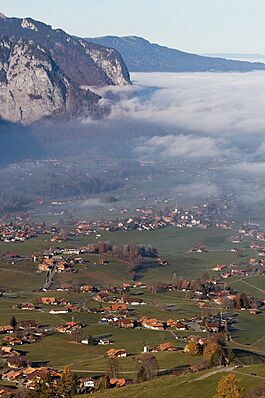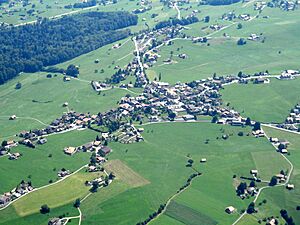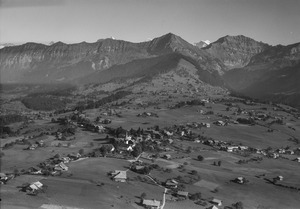Aeschi bei Spiez facts for kids
Quick facts for kids
Aeschi bei Spiez
|
||
|---|---|---|

Aeschi bei Spiez village
|
||
|
||
| Country | Switzerland | |
| Canton | Bern | |
| District | Frutigen-Niedersimmental | |
| Area | ||
| • Total | 30.99 km2 (11.97 sq mi) | |
| Elevation | 860 m (2,820 ft) | |
| Highest elevation | 1,400 m (4,600 ft) | |
| Lowest elevation | 850 m (2,790 ft) | |
| Population
(Dec 2020 )
|
||
| • Total | 2,256 | |
| • Density | 72.798/km2 (188.55/sq mi) | |
| Postal code |
3703
|
|
| Surrounded by | Krattigen, Lauterbrunnen, Leissigen, Reichenbach im Kandertal, Saxeten, Spiez, Wimmis | |
Aeschi bei Spiez is a small town, also called a municipality, in Switzerland. It is located in the Frutigen-Niedersimmental area within the canton of Bern.
Contents
History
Aeschi bei Spiez was first written about in the year 1228. Back then, it was called Asshes. Later, in 1269, it was known as (villa) Esche.
Early Times
People have lived in this area for a very long time. We know this because old graves and tools from the La Tene era have been found here. During the Middle Ages, Aeschi was part of a special territory called Herrschaft of Mülenen. This land was controlled by powerful families, like the Lords of Kien.
By the 1200s, Aeschi was an important center for a large church area, known as a parish. The old Romanesque church of St. Peter was first mentioned in 1228. Inside the church, there are beautiful frescoes, which are wall paintings, from the 1300s.
Becoming Part of Bern
In 1352, the city of Bern bought the land where Aeschi is located. However, other noble families still had some legal rights over the village. At first, Aeschi was part of the Mülenen district under Bern's rule. But in the 1400s and 1500s, it became part of the Frutigen area. The rules for how the town was run were first written down in 1469.
In 1528, Bern made the villagers change their religion to Protestantism. The next year, the church area was divided, and the nearby village of Reichenbach became its own separate parish.
Modern Growth
During the 1800s, the local economy wasn't growing much, and the number of people living in the village started to go down. However, when tourism became popular in the late 1800s, the population began to grow again.
In 1855, a health spa called Bad Heustrich opened in Aeschi. It quickly became a famous place for visitors. In 1901, the Lötschberg railroad made it easier for more tourists to visit. A train station opened in Mülenen in 1906. In the late 1960s, many new buildings were constructed as more people moved to the area and wanted vacation homes. By 1990, most people in Aeschi worked in jobs that provided services, like hotels or shops.
Geography
Aeschi bei Spiez covers an area of about 30.9 square kilometers (about 11.9 square miles).
Land Use
- Almost half of the land (46.3%) is used for farming.
- More than a quarter (27.4%) is covered by forests.
- About 5.1% of the land has buildings or roads.
- A small part (1.2%) is rivers or lakes.
- The remaining 19.7% is land that cannot be used for farming or building, like rocky areas.
Most of the forests are dense, and some areas have orchards. For farming, about 20.6% of the land is used for pastures, and 25.2% is for alpine pastures, which are high mountain grasslands.
Location and Areas
Aeschi bei Spiez is located on a ridge, which is a long, narrow hilltop. This ridge sits between the Kander valley and Lake Thun. The municipality includes several smaller areas: Aeschi bei Spiez itself, Aeschiried, Heustrich-Emdtal, Mülenen, and Alpen im hinteren Suldtal. The main church in Aeschi also serves the nearby town of Krattigen.
On January 1, 2010, the old district of Frutigen was changed. Aeschi bei Spiez then became part of the new Frutigen-Niedersimmental administrative district.
Coat of Arms
The design on the municipal coat of arms shows a black bear paw coming out from the top left corner on a silver background.
People of Aeschi
Aeschi bei Spiez has a population of about 2,200 people. As of 2010, about 4.9% of the people living here were from other countries. Over the last ten years (2000-2010), the population grew by about 8.4%. Most of this growth was because more people moved into the area than moved out.
Population Details
As of 2000, most people (95.2%) in Aeschi bei Spiez speak German as their main language. The next most common languages are Serbo-Croatian and Albanian. A few people also speak French or Italian.
In 2008, the population was almost equally split between men (50.2%) and women (49.8%). About 36.4% of the people living in Aeschi in 2000 were also born there. Many others were born in the same canton (39.7%) or elsewhere in Switzerland (12.4%). About 7.8% were born outside Switzerland.
As of 2010, young people (0–19 years old) make up 23.4% of the population. Adults (20–64 years old) are the largest group at 60.2%, and seniors (over 64 years old) make up 16.4%.
In 2000, about 924 people were single. There were 902 married people, 116 widows or widowers, and 83 divorced individuals.
Languages and Families
In 2000, there were 223 homes where only one person lived. There were also 95 homes with five or more people. Most apartments (71.9%) were lived in all the time. Some (24.2%) were used only during certain seasons, like vacation homes.
What People Do
In 2011, Aeschi bei Spiez had a very low unemployment rate of 0.66%. This means almost everyone who wanted a job had one. In 2008, 871 people worked in the municipality.
Jobs and Industries
Jobs are often grouped into three main types:
- Primary sector: This includes jobs like farming and forestry. In 2008, 177 people worked in this sector, with 71 businesses.
- Secondary sector: This includes jobs in manufacturing (making things) and construction (building things). There were 123 people working in this sector, with 20 businesses.
- Tertiary sector: This includes jobs that provide services, like hotels, restaurants, shops, healthcare, and education. This was the largest sector, with 571 people working in 75 businesses.
In 2008, there were 625 full-time jobs in Aeschi. Many jobs in the tertiary sector were in hotels or restaurants (108 jobs), or in healthcare (120 jobs).
Getting to Work
In 2000, 298 people came into Aeschi bei Spiez for work, while 497 people left the municipality to work elsewhere. This means more people leave Aeschi for work than come in. About 10.6% of working people used public transportation to get to their jobs, and 52.4% used a private car.
Religions
Based on the 2000 census, most people in Aeschi bei Spiez belong to the Swiss Reformed Church (77.0%). About 7.4% are Roman Catholic. There are also smaller groups of people who belong to other Christian churches, Orthodox churches, or follow Islam or Buddhism. About 4.4% of the population did not belong to any church or were agnostic or atheist.
Learning and Schools
In Aeschi bei Spiez, about 37.5% of the population has finished upper secondary education, which is like high school. About 9.6% have gone on to higher education, either at a university or a specialized college.
Education System
The Canton of Bern has a school system that starts with one year of optional Kindergarten. After that, students go to six years of Primary school. Then, they attend three years of lower Secondary school. In secondary school, students are grouped based on their abilities. After lower secondary school, students can choose to continue their education or start an apprenticeship, where they learn a trade while working.
Local Schools
During the 2010-2011 school year, 283 students attended schools in Aeschi bei Spiez.
- There were 2 kindergarten classes with 37 students.
- There were 7 primary classes with 121 students.
- There were 5 lower secondary classes with 103 students.
In 2000, 64 students came to Aeschi bei Spiez from other towns to go to school. At the same time, 52 students from Aeschi went to schools outside the municipality.
The Library
Aeschi bei Spiez has a library called Bibliothek Aeschi. In 2008, the library had 1,800 books and other media. It loaned out 750 items that year. The library was open for 260 days and for about 39 hours per week.
Images for kids
See also
 In Spanish: Aeschi bei Spiez para niños
In Spanish: Aeschi bei Spiez para niños







